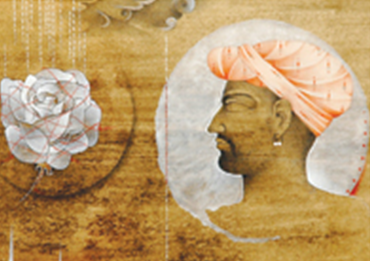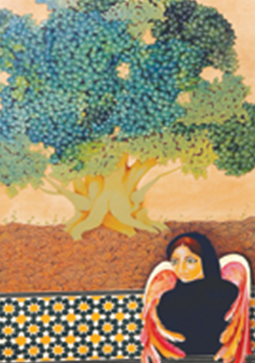Miniature painting: Pakistan
This is a collection of articles archived for the excellence of their content. Readers will be able to edit existing articles and post new articles directly |
Miniature painting
Miniature Aesthetics
By Amra Ali
To what extents have contemporary miniaturists been able to expand on the issues and aesthetics of their medium? Have they been able to synthesise from a language of the past to uncover new meanings in the present? These are some of the questions that should be asked of these artists and their art. To understand the progression of miniature after it became such a hot commodity internationally, it is necessary to know what has been demanded of the medium, first, by the artist and second, but of no less importance, by the art market. Who and where is this market? To what extent is the ‘work’ that is called miniature the product of market demand?
There is, of course, the prime example of Shazia Sikander, who made it big in the international art circuit. The mere name of MOMMA New York and big museums in the West that embraced Shazia’s work opened new avenues for other miniaturists from the National College of Art, Lahore. It has to be more than just being at the right place at the right time for these successes, because the exponents of what has been called the ‘Neo miniature’ school, like Imran Qureshi, Nusra Latif, Tazeen Qayyum and Aisha Khalid and others, seem to have addressed audiences not only internationally, but have found a following among younger graduates at home: some who have cashed in on the formula of the miniature aesthetics for sales alone; others, who are using it as a tool to comment on the socio-politics as it relates to this region.
Despite the fame and sudden popularity of Pakistani art due to the international interest in the miniature, which has often overshadowed multiple concerns within it, there are other dimensions to miniature, such as a subtle commentary on Western rules of aesthetics through constructing frameworks that chose to question these ‘established’ norms. The vocabulary that started brewing since Zahoor Al Akhlaq began his dialogue with the miniature suddenly exploded probably because there was a space needed for the Pakistani artists to look within, and to find a language that was situated in the present, but took its inspiration from the traditional aesthetics from their own cultural past. Writers have criticised these artists as having created a false perception, by unnecessarily drawing from a time period in history that is dead, claiming that the only reason for revisiting the Mughal Ateliers has been to gain entry into the international art market that chooses to slot Pakistani artists into that of the ‘other’ or the ‘exotic’; hence keeping it contained within the parameters defined by the West and denied it access or entry into the mainstream.
Back home, galleries in Karachi continue to exhibit the work of a growing number of miniature graduates, as more institutions integrate this genre into their curricula. Karachi remains the economic and cultural hub where new entrants gain their first exposure to a growing community of collectors and writers on art. Recently, Chawkandi Art Gallery in Karachi exhibited the work of two miniaturists from the NCA, Asif and Sobia Ahmed.
Asif’s vocabulary takes reference from the Kangra School in a very strict allegiance to the original framework of the art form. Not only does he insists on the importance of technique and skill, but makes a point of choosing to remain well within the traditional boundaries of original miniature. There are two schools of practice of the miniature originating from Lahore, one of the old school approaches of adhering strictly to the original and the other more experimental of artists like Imran Qureshi, whose vocabulary expands to deconstruct/reconstruct the original, and incorporates installation, sound and 4-D space. Although Asif’s work and approach can be located somewhere close to the
first, he makes an interesting point that he would prefer to continue to perfect his technique and wait for a change or transformation to happen spontaneously over time; he does not believe in approaching social or political issues, as that, he says, has also become an expectation and a formula for Neo-miniaturists.
His current body of work deals with the theme of love. Reference to cupid, some times a rose, strings, and rain drops drawn in the Kangra style, are the main imagery around which his compositions are arranged. The god Krishna emerges as another repeated visual element. The haashia or the frame remains consistently uniform, serving its presence as a rule to be followed, rather than an element that could be explored beyond its original structure. This is where one can see the deficiency within miniature today: the primary purpose of the artist has been to paint a picture with the main emphasis on skill rather than on a conceptual dialogue. The past and the present may coexist in a harmonious arrangement of colour and form, but whether or not they should be doing something beyond, is an important question to the artist. What is his point of view? This is the point that seems to separate the more innovative and the ‘copyists’, although Asif’s cautious and slow approach could prove to be an asset in being able to discover something more original and his own. There is, of course, the danger of him relying totally on his craftsmanship and skill that he seems to have mastered already, in producing paintings that will sell well to decorate drawing rooms, and only that!
Sobia Ahmed, who also shows at the same exhibition, uses the imagery of a girl, a cat, crows, leaves, trees and roots. Her narrative is more fluid compared to Asif’s and her frame merges, sometimes dissolves, with the rest of the page. An intentional way of addressing the frame, Sobia’s approach can be read as a more playful and humorous response to traditional miniature. There is something more than the sacredness of miniature which makes this body of work more appealing, because there is an awkward ambiguity that suggests that the artist is engaged on more than just surface decoration. It is this ambiguity that can help explore new dimensions to this art form, be it for the local, Diaspora or the international audience.





